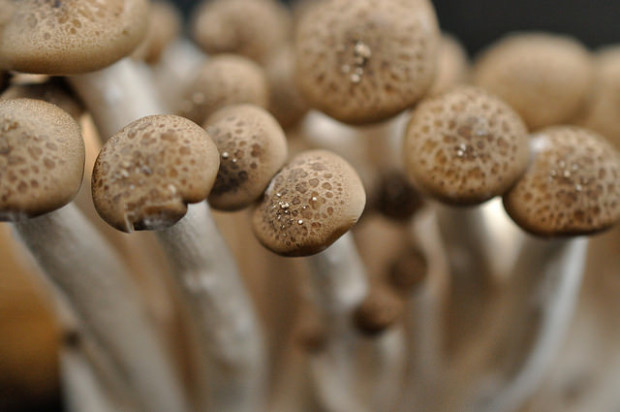You have no items in your cart. Want to get some nice things?
Go shopping
“Therefore I give my simple advice unto those that love such strange and newe-fangled meates, to beware licking honey among thornes, least the sweetness of the one do not countervaile the sharpnes and prickling of the other.”
– John Gerard, The Herball or Generall Historie of Plantes, 1597
There are few people out there who will share my enthusiasm for the gathering grey skies that have come to define the last couple of weeks. As balmy summer days picking canalside raspberries give way to the familiar damp of insolent British drizzle, my mounting excitement has been difficult to hem in. Pulling on my wellington boots, I know that the arrival of rain after a warm summer can only mean one thing: mushrooms.
I am what Lorna Bunyard once referred to as “a confirmed toadstool eater”[1], always keeping half an eye out for these mysterious fruits of the earth. It is no wonder that Mrs Bunyard’s chapter on mushrooms should follow a chapter entitled Strange Meats, however, as this is, historically, how they have been perceived by the British. John Gerard, perhaps our most revered botanist, was certainly not a fan, affirming that they “do hunger after the earthie excrescences”[2] – an association he makes more than once – whilst noting their habit of popping up on the “rotting bodies of trees” in “dankish”, “shadowie”[3] places. Gerard dismisses fungi as “unproffitable” and “nothing worth”[4], repeatedly warning the reader that they are “full of poison” and “deadly”[5].
Of course now we know that this isn’t actually the case. Of the 3,000 or so species of fungi that can be found in the British Isles [6], only around twenty are gravely poisonous (though many more are too tough or bitter to make for desirable eating) [7]. Though these poisonous species sometimes resemble and mimic the habits of edible ones – making careful examination an important rite of any foray – this does not quite explain why the British are so sceptical about fungi. It was not until the war years that the British public “came to realize that not only the mushroom, but other fungi also … were edible, nutritious and palatable”[8], and certainly not until this century that we started in earnest to explore varieties other than Agaricus bisporus for their culinary possibilities.
British cultural aversion to these new-fangled meates [9] is evinced by Gerard’s description of the treatment of puffballs. Where in other countries they were renowned for their culinary value, in sixteenth century Britain, “the people where they grow [were] constrained to dig them up and cast them abroad like Molehills”[10], or “set [them] on fire” to “kill and smother Bees” [11]. This strange violence towards fungi is something that I see regularly on my walks, where some poor, unsuspecting fungus pops its head up, only to be raked over or kicked to pieces by a passing tyrant. More often than not, these species are edible, and leave me feeling as though I’ve been deprived of a free, succulent morsel.
By comparison, many early creation stories, from South Africa to the Philippines [12][13], feature mushrooms as a metaphor for the beginning of the world. Other world cultures have long enjoyed the bounty that the fungi have to offer, with mushroom foraging forming an integral part of economic and social activity in many societies. In mainland Europe their importance can be seen throughout history, from Lorenzo de’ Medici’s verses dedicated to cheerful women gathering mushrooms in verdant meadows [14], to the earliest attempts by the French to cultivate them in 1707 [15].
Even our most cherished, forward-thinking writers are subject to this prejudice – with Shakespeare’s Prospero deriding the “green sour ringlets” of “midnight mushrumps” that the fairies make, alluding to the erroneous folklore that livestock will not graze where poisonous mushrooms lie [16]. Only thirty years later in France, Molière named perhaps his most famous protagonist after the delectable, subterranean truffle, or Tartuffe. For all his pastoral sensitivity, even Keats fails to see virtue in the mycological kingdom, describing its denizens as “night-swollen” [17] and “cold” [18] two centuries later.
Fortunately, by the time Victoria had ascended the throne, someone had come to defend the virtues of these hidden riches in the form of Rev. Dr. Charles David Badham. Badham learned of the value of edible fungi whilst practising medicine in France and Italy, and, having noted the nutritive, culinary and economic benefits that they could offer – particularly to the most disenfranchised in society [19] – published A Treatise on the Esculent Funguses of England in 1847. The volume is informative and witty, and even if some of the information contained in it has been improved upon since, will still prove an interesting read to the amateur mycologist. In the volume, Badham notes how strange it is that we are so fearful of fungi when we regularly eat of a genus renowned for its poison, Solanaceae [20].
Badham definitively won my affection when bemoaning the fierce neglect of one of my favourite mushrooms, the cep, once affectionately known in this country as the Penny Bun: “the sweet, nutty-flavoured Boletus, in vain calling himself edulis where there was none to believe him” [21]. When I was little, there were few things I would look forward to more than when my uncle would turn up with jars of gold: porcini mushrooms preserved in rosemary-infused olive oil. Even today, there are few foods that are able to match the delight that they bring about in me.
Luckily, the fate of fungi is slowly changing in the UK. The determined efforts of a few intrepid people, from Victorians and twentieth century Bohemians, to the UK’s rich and diverse immigrant populations of which I am a part, finally seem to be paying off. Only this year did Dr Paul Thomas harvest the first cultivated truffle in Leicestershire [22]. Hopefully our interest in these delicacies will encourage us to afford greater protections to the hedgerows and woodland in which they thrive, and will inspire us all to go in search of the more common place treats growing closer to home.
[1] Bunyard, Edward A, and Lorna Bunyard, The Epicure’s Companion (London: J.M. Dent & Sons Ltd, 1937), p.120.
[2] Gerard, John et al, The Herball, Or, Generall Historie Of Plantes (London: John Norton, 1597), p.1384.
[3] Ibid., 1386.
[4] Ibid.
[5] Ibid., p.1385.
[6] Phillips, Roger, and Lyndsay Shearer, Mushrooms And Other Fungi Of Great Britain And Europe (London: Pan Books, 1981), p.6.
[7] Mabey, Richard, Food For Free (London: Collins, 2007), p.182.
[8] Ibid.
[9] Gerard, John et al., The Herball, Or, Generall Historie Of Plantes (London: John Norton, 1597).
[10] Ibid.
[11] Ibid., p.1387.
[12] Kirby, Jimmy. ‘Creation Stories: Uniting Humanity To Educe A Holistic Understanding Of The African Worldview’, 31 St Annual National Council For Black Studies Conference (New York: Cornell University, 2007. 9). Aug 16 2015.
[13] Demetrio, Francisco, Creation Myths Among The Early Filipinos, Asian Folklore Series (Tokyo), XXVII, 1968, p.56.
[14] Lorenzo de’ Medici, Selve, in Opere, edited by Tiziano Zanato (Torino: Einaudi, 1992), p.457.
[15] Tournefort, Joseph, Observations sur la naissance et sur la culture des champignons. Memoires de mathematique et de physique de l’Academie royale des sciences (Academie royale des sciences, 1707).
[16] Shakespeare, William, and Cedric Thomas Watts, The Tempest (Ware: Wordsworth Editions Limited), 2004. 5.1: 3639.
[17] Keats, John and John Barnard, Selected Poems: Keats (London: Penguin Classics, 2007), p.42.
[18] Ibid., p.91.
[19] Badham, David, A Treatise On The Esculent Funguses Of England (London: Lovell Reeve), 1863, p.viii.
[20] Ibid., p.39.
[21] Ibid., p.150.
[22] ‘First UK-farmed truffle harvested’, BBC News, Aug 18 2015.

About Concepta Cassar
Concepta is a journalist, forager and food writer, with a particular interest in food anthropology, sustainability, and agricultural affairs. Her recipes have been featured in the Guardian, and she writes for a number of organisations, including BuzzFeed, Aftertastes, and the Soil Association. Her other great loves are literature and modern languages. Concepta speaks French and Italian, and has a working knowledge of Spanish and Russian.





Hey, You be glad to know that here we are having the best site for you to add printer to windows 10 smoothly without facing any type of error and problems. This site includes serviceable methods.